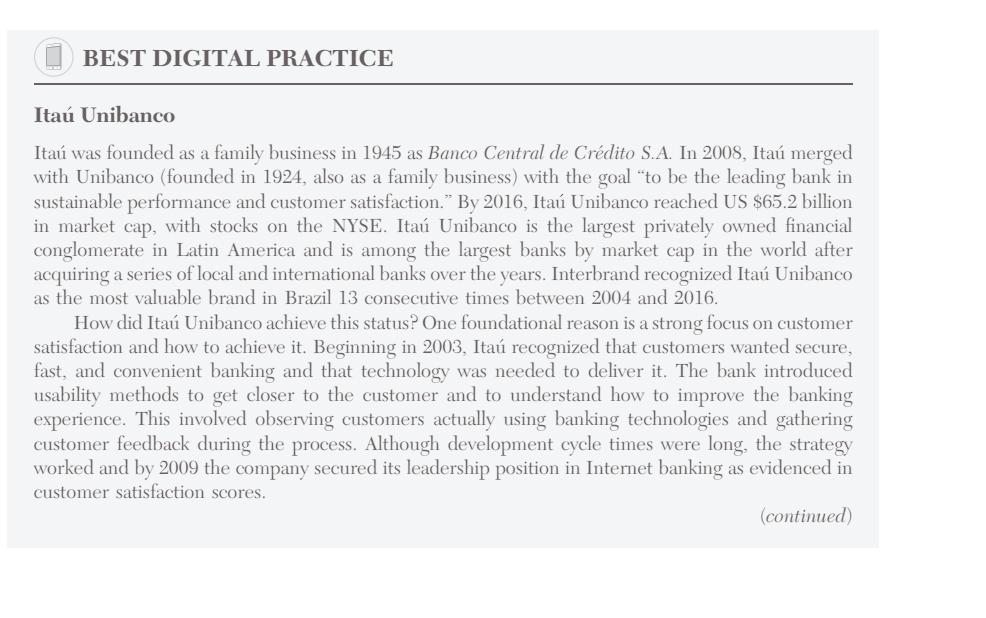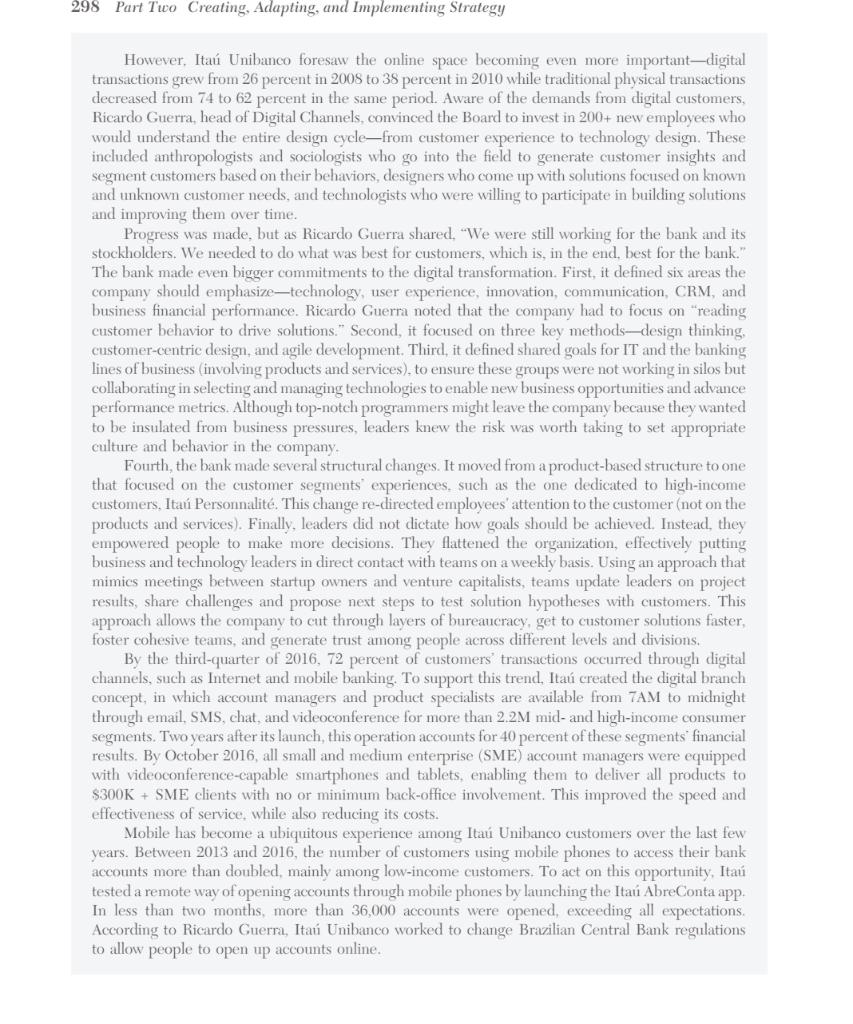Question
Read the mini case and identify the following. 500 word count. 1. Problem Identification Identify the major problems found in the case. Ensure that you



| Read the mini case and identify the following. 500 word count.
1. Problem Identification Identify the major problems found in the case. Ensure that you distinguish between causes and symptoms. Causes may include changing customer preferences, increased competition, etc. Symptoms include declining revenues, loss of brand equity, increased customer churn, etc. Please support your problem identification by relevant case facts along with the associated theory and concepts.
2. Quantitative Reasoning and Analysis Conduct research to identify data (e.g., obtain data in the form of trends, statistics, ratings, etc. from the library and other sources) that can be utilized to provide additional insight into the case. Draw appropriate conclusions based on the quantitative analysis of data, while recognizing the limits of this analysis.
3. Discussion and Recommendation Identify and recommend a solution to the major problem in the case (there is likely to be more than one solution). Briefly outline your solution and evaluate it in terms of its pros and cons. Always ensure that your recommendations are supported by statistical evidence and provide spreadsheets as necessary.
4. Appendix and References Please include any tables or figures that are not included but are referenced in your report. Make sure all references are cited correctly.
|
Ita Unibanco Ita was founded as a family business in 1945 as Banco Central de Crdito S.A. In 2008, Ita merged with Unibanco (founded in 1924, also as a family business) with the goal "to be the leading bank in sustainable performance and customer satisfaction." By 2016 , Ita Unibanco reached US $65.2 billion in market cap, with stocks on the NYSE. Ita Unibanco is the largest privately owned financial conglomerate in Latin America and is among the largest banks by market cap in the world after acquiring a series of local and international banks over the years. Interbrand recognized Ita Unibanco as the most valuable brand in Brazil 13 consecutive times between 2004 and 2016. How did Ita Unibanco achieve this status? One foundational reason is a strong focus on customer satisfaction and how to achieve it. Beginning in 2003, Ita recognized that customers wanted secure, fast, and convenient banking and that technology was needed to deliver it. The bank introduced usability methods to get closer to the customer and to understand how to improve the banking experience. This involved observing customers actually using banking technologies and gathering customer feedback during the process. Although development cycle times were long, the strategy worked and by 2009 the company secured its leadership position in Internet banking as evidenced in customer satisfaction scores. (continued) However, Ita Unibanco foresaw the online space becoming even more important-digital transactions grew from 26 percent in 2008 to 38 percent in 2010 while traditional physical transactions decreased from 74 to 62 percent in the same period. Aware of the demands from digital customers, Ricardo Guerra, head of Digital Channels, convinced the Board to invest in 200+ new employees who would understand the entire design cycle-from customer experience to technology design. These included anthropologists and sociologists who go into the field to generate customer insights and segment customers based on their behaviors, designers who come up with solutions focused on known and unknown customer needs, and technologists who were willing to participate in building solutions and improving them over time. Progress was made, but as Ricardo Guerra shared, "We were still working for the bank and its stockholders. We needed to do what was best for customers, which is, in the end, best for the bank." The bank made even bigger commitments to the digital transformation. First, it defined six areas the company should emphasize-technology, user experience, innovation, communication, CRM, and business financial performance. Ricardo Guerra noted that the company had to focus on "reading customer behavior to drive solutions." Second, it focused on three key methods-design thinking. customer-centric design, and agile development. Third, it defined shared goals for IT and the banking lines of business (involving products and services), to ensure these groups were not working in silos but collaborating in selecting and managing technologies to enable new business opportunities and advance performance metrics. Although top-notch programmers might leave the company because they wanted to be insulated from business pressures, leaders knew the risk was worth taking to set appropriate culture and behavior in the company. Fourth, the bank made several structural changes. It moved from a product-based structure to one that focused on the customer segments' experiences, such as the one dedicated to high-income customers, Ita Personnalit. This change re-directed employees' attention to the customer (not on the products and services). Finally, leaders did not dictate how goals should be achieved. Instead, they empowered people to make more decisions. They flattened the organization, effectively putting business and technology leaders in direct contact with teams on a weekly basis. Using an approach that mimics meetings between startup owners and venture capitalists, teams update leaders on project results, share challenges and propose next steps to test solution hypotheses with customers. This approach allows the company to cut through layers of bureaucracy, get to customer solutions faster, foster cohesive teams, and generate trust among people across different levels and divisions. By the third-quarter of 2016,72 percent of customers' transactions occurred through digital channels, such as Internet and mobile banking. To support this trend, Ita created the digital branch concept, in which account managers and product specialists are available from 7AM to midnight through email, SMS, chat, and videoconference for more than 2.2Mmid - and high-income consumer segments. Two years after its launch, this operation accounts for 40 percent of these segments financial results. By October 2016, all small and medium enterprise (SME) account managers were equipped with videoconference-eapable smartphones and tablets, enabling them to deliver all products to $300K+ SME clients with no or minimum back-office involvement. This improved the speed and effectiveness of service, while also reducing its costs. Mobile has become a ubiquitous experience among Ita Unibanco customers over the last few years. Between 2013 and 2016 , the number of customers using mobile phones to access their bank accounts more than doubled, mainly among low-income customers. To act on this opportunity, Ita tested a remote way of opening accounts through mobile phones by launching the Itau AbreConta app. In less than two months, more than 36,000 accounts were opened, exceeding all expectations. According to Ricardo Guerra, Ita Unibanco worked to change Brazilian Central Bank regulations to allow people to open up accounts online. Ita has also expanded its collaborative, cross-functional digital operations to accommodate the startup ecosystem by creating a co-working space named Cubo that hosts 55 startups. This venture nurtures the Brazilian entrepreneurial space, promotes inspiring and networking events, and gives the bank access to top-notch talent in the digital space. Ita Unibanco's culture was an important part of the success of these strategic and structural changes. Nosso Jeito (Our Way) consists of seven attitudes that reflect expectations. These include "It's only good for us if it's good for our client," "We're passionate about performance," and "Simple. Always." Acting on these cultural values, leaders pushed teams to implement solutions that could disrupt and expand current experiences. This approach was risky, so leaders also had to allow failure in the short term. Moreover, leaders sent a message to the whole organization through the annual Walther Moreira Salles Award, which recognizes best practices and results in categories such as customer satisfaction and innovation. In 2015,803 projects were registered to compete for the award. Ita Unibanco's digital retail financial results increased by 43 percent between 2014 and 2016 and secured its leadership position in digital satisfaction, scoring 9 and 8.5 points out of a 10 point-scale for consumer (noncommercial) and SME segments, respectively. In addition, Ita was recognized as the most reputable bank among retail banks in the 2014 Brazilian Consumer Satisfaction Index (BCSI). Ricardo Guerra summed up Ita Unibanco's successful journey by noting: "Over the years, we have thought about and revised our solutions, our branches, our customer service model, and the way we work. We progressed by bringing the client into the core of our operation, working to strengthen the bank's availability and the client's experience." Questions: 1. What organizational factors were important to Ita' Unibanco's digital transformation? 2. What growth opportunities do you envision for Ita Unibanco and what is the best organizational approach to develop and implement these growth strategies? Ita Unibanco Ita was founded as a family business in 1945 as Banco Central de Crdito S.A. In 2008, Ita merged with Unibanco (founded in 1924, also as a family business) with the goal "to be the leading bank in sustainable performance and customer satisfaction." By 2016 , Ita Unibanco reached US $65.2 billion in market cap, with stocks on the NYSE. Ita Unibanco is the largest privately owned financial conglomerate in Latin America and is among the largest banks by market cap in the world after acquiring a series of local and international banks over the years. Interbrand recognized Ita Unibanco as the most valuable brand in Brazil 13 consecutive times between 2004 and 2016. How did Ita Unibanco achieve this status? One foundational reason is a strong focus on customer satisfaction and how to achieve it. Beginning in 2003, Ita recognized that customers wanted secure, fast, and convenient banking and that technology was needed to deliver it. The bank introduced usability methods to get closer to the customer and to understand how to improve the banking experience. This involved observing customers actually using banking technologies and gathering customer feedback during the process. Although development cycle times were long, the strategy worked and by 2009 the company secured its leadership position in Internet banking as evidenced in customer satisfaction scores. (continued) However, Ita Unibanco foresaw the online space becoming even more important-digital transactions grew from 26 percent in 2008 to 38 percent in 2010 while traditional physical transactions decreased from 74 to 62 percent in the same period. Aware of the demands from digital customers, Ricardo Guerra, head of Digital Channels, convinced the Board to invest in 200+ new employees who would understand the entire design cycle-from customer experience to technology design. These included anthropologists and sociologists who go into the field to generate customer insights and segment customers based on their behaviors, designers who come up with solutions focused on known and unknown customer needs, and technologists who were willing to participate in building solutions and improving them over time. Progress was made, but as Ricardo Guerra shared, "We were still working for the bank and its stockholders. We needed to do what was best for customers, which is, in the end, best for the bank." The bank made even bigger commitments to the digital transformation. First, it defined six areas the company should emphasize-technology, user experience, innovation, communication, CRM, and business financial performance. Ricardo Guerra noted that the company had to focus on "reading customer behavior to drive solutions." Second, it focused on three key methods-design thinking. customer-centric design, and agile development. Third, it defined shared goals for IT and the banking lines of business (involving products and services), to ensure these groups were not working in silos but collaborating in selecting and managing technologies to enable new business opportunities and advance performance metrics. Although top-notch programmers might leave the company because they wanted to be insulated from business pressures, leaders knew the risk was worth taking to set appropriate culture and behavior in the company. Fourth, the bank made several structural changes. It moved from a product-based structure to one that focused on the customer segments' experiences, such as the one dedicated to high-income customers, Ita Personnalit. This change re-directed employees' attention to the customer (not on the products and services). Finally, leaders did not dictate how goals should be achieved. Instead, they empowered people to make more decisions. They flattened the organization, effectively putting business and technology leaders in direct contact with teams on a weekly basis. Using an approach that mimics meetings between startup owners and venture capitalists, teams update leaders on project results, share challenges and propose next steps to test solution hypotheses with customers. This approach allows the company to cut through layers of bureaucracy, get to customer solutions faster, foster cohesive teams, and generate trust among people across different levels and divisions. By the third-quarter of 2016,72 percent of customers' transactions occurred through digital channels, such as Internet and mobile banking. To support this trend, Ita created the digital branch concept, in which account managers and product specialists are available from 7AM to midnight through email, SMS, chat, and videoconference for more than 2.2Mmid - and high-income consumer segments. Two years after its launch, this operation accounts for 40 percent of these segments financial results. By October 2016, all small and medium enterprise (SME) account managers were equipped with videoconference-eapable smartphones and tablets, enabling them to deliver all products to $300K+ SME clients with no or minimum back-office involvement. This improved the speed and effectiveness of service, while also reducing its costs. Mobile has become a ubiquitous experience among Ita Unibanco customers over the last few years. Between 2013 and 2016 , the number of customers using mobile phones to access their bank accounts more than doubled, mainly among low-income customers. To act on this opportunity, Ita tested a remote way of opening accounts through mobile phones by launching the Itau AbreConta app. In less than two months, more than 36,000 accounts were opened, exceeding all expectations. According to Ricardo Guerra, Ita Unibanco worked to change Brazilian Central Bank regulations to allow people to open up accounts online. Ita has also expanded its collaborative, cross-functional digital operations to accommodate the startup ecosystem by creating a co-working space named Cubo that hosts 55 startups. This venture nurtures the Brazilian entrepreneurial space, promotes inspiring and networking events, and gives the bank access to top-notch talent in the digital space. Ita Unibanco's culture was an important part of the success of these strategic and structural changes. Nosso Jeito (Our Way) consists of seven attitudes that reflect expectations. These include "It's only good for us if it's good for our client," "We're passionate about performance," and "Simple. Always." Acting on these cultural values, leaders pushed teams to implement solutions that could disrupt and expand current experiences. This approach was risky, so leaders also had to allow failure in the short term. Moreover, leaders sent a message to the whole organization through the annual Walther Moreira Salles Award, which recognizes best practices and results in categories such as customer satisfaction and innovation. In 2015,803 projects were registered to compete for the award. Ita Unibanco's digital retail financial results increased by 43 percent between 2014 and 2016 and secured its leadership position in digital satisfaction, scoring 9 and 8.5 points out of a 10 point-scale for consumer (noncommercial) and SME segments, respectively. In addition, Ita was recognized as the most reputable bank among retail banks in the 2014 Brazilian Consumer Satisfaction Index (BCSI). Ricardo Guerra summed up Ita Unibanco's successful journey by noting: "Over the years, we have thought about and revised our solutions, our branches, our customer service model, and the way we work. We progressed by bringing the client into the core of our operation, working to strengthen the bank's availability and the client's experience." Questions: 1. What organizational factors were important to Ita' Unibanco's digital transformation? 2. What growth opportunities do you envision for Ita Unibanco and what is the best organizational approach to develop and implement these growth strategies
Step by Step Solution
There are 3 Steps involved in it
Step: 1

Get Instant Access to Expert-Tailored Solutions
See step-by-step solutions with expert insights and AI powered tools for academic success
Step: 2

Step: 3

Ace Your Homework with AI
Get the answers you need in no time with our AI-driven, step-by-step assistance
Get Started


